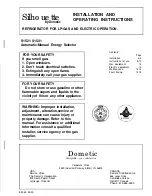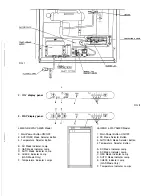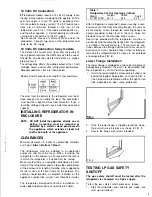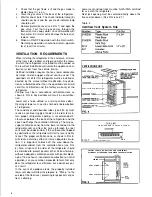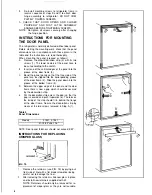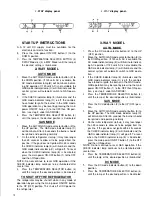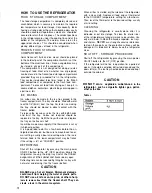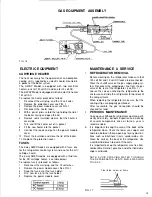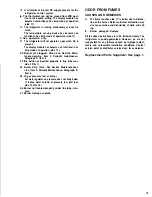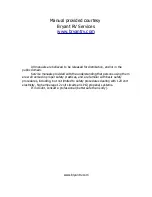
B. Check all connections in the LP gas system (at the
back of the refrigerator) for gas leaks. The LP gas
supply must be turned on. Apply a non-corrosive
bubble solution to all LP gas connections. The ap-
pearance of bubbles indicates a leak and should be
repaired immediately by a QUALIFIED SER-
VICEMAN WHO IS FAMILIAR WITH GAS SYSTEM
AND REFRIGERATORS.
WARNING
DO NOT
use a flame to check for gas leaks.
c.
D.
E.
1.
2.
3.
4.
5.
6.
7.
8.
9.
Check
the AMES control system by connecting/dis-
connecting 120 volt AC power, start/stop the en-
gine, etc. Compare the operation with the operation
described in description of operating modes. Side
14.
NOTE:
The following maintenance is required once
or twice a year, but should only be done by a
qualified serviceman who is familiarwith LP gas sys-
tems and refrigerators.
The LP gas pressure should be checked and the
main regulator re-adjusted if pressure is incorrect.
The correct operating pressure is 11 inches of water
column. The correct place to take the LP gas pres-
sure is at the test port just ahead of the burner jet.
(See FIG. 16).
Inspect
the
flue baffle. It should be reasonably clean
and free of soot. Heavy soot formation indicates im-
proper functioning of the burner. The flue and
burner both require cleaning in the following man-
ner:
Unplug the refrigerator power cord from the 120 volt
AC outlet. (See FIG. 3).
Disconnect or shut off the 12 volt power to the
refrigerator.
Turn manual shutoff valve to OFF.(See FIG. 1).
Remove cover from the burner housing. (See FIG.
1).
Disconnect the wire from the high voltage electrode.
Remove the burner mounting screws and remove
the burner assembly. (See FIG. 16).
Remove the flue cap from top of flue tube and lift out
the wire and spiral baffle. Clean the flue from the top
using a flue brush. Blowing compressed air into the
flue will not properly clean soot and scale out of the
flue tube. Replace spiral baffle and flue cap.
Clean burnertube with a brush. Blow out bumerwith
compressed air.
Before removing burner jet, clean burner area of
soot and scale that fell out of flue tube. Remove the
burner jet. Soak the jet in wood alcohol and blow it
out with compressed air. Re-install and tighten
burner jet.
NOTE:The color of the flame shall be clear
blue over
the slots of the burner. (See FIG.
17).
CAUTION
DO NOT use a wire or pin when cleaning the burner
jet as damage can occur to the precision opening.
This can cause damage to the. refrigerator or create
a fire hazard.
10.
11.
Reinstall burner, being careful that the end of the
burner fits into the slot on the burner bracket. Check
to make sure slots are centered under the flue tube
and the thermocouple is positioned properly (tip of
thermocouple extends over two slots of burner)
Be
sure
to reconnect the wire to high voltage
electrode. Check the electrode for proper location
and gap. (See FIG. 18).
FIG. 18
12.
13.
14.
(3-5
mm)
BURNER TUBE
Turn on manual gas shutoff valve and check all fit-
tings for leaks.
Connect 120
volt power cord to the outlet and
reconnect or turn on the 12 volt DC power.
Check LP gas safety shoutoff. See side 5 and 6.
TROUBLESHOOTING
The Refrigerator Does Not Cool Properly
Causes and remeides
Failure of refrigeration does not necessairily indicate that
the cooling system is defective. Other factors governing
its operation must be checked.
1.
1 a.
1 b.
1 c.
1 d.
1 e.
Common.
Fuse(s) blown, replace (see side 13).
Check level of refrigerator.
Venting problem. Restriction in airflow across cool-
ing unit
Heavy frost buildup on evaporator fins, defrost.
If the refrigerator has been operating on gas and a
loss of cooling is noted, convert the refrigerator to
AC power (see start up instructions side 10).
If
the refrigerator has been operating on AC, switch
to gas operation. This will determine if
a component
failure in the electric or gas controls is causing the
cooling fault. After the refrigerator has been con-
verted from one power source to the other (gas to
AC, or AC to gas) allow time to assure the unit is cy-
cling properly. At the end of the period the freezer
plate should start to cool.
14
Summary of Contents for Silhouette S1521
Page 14: ......

